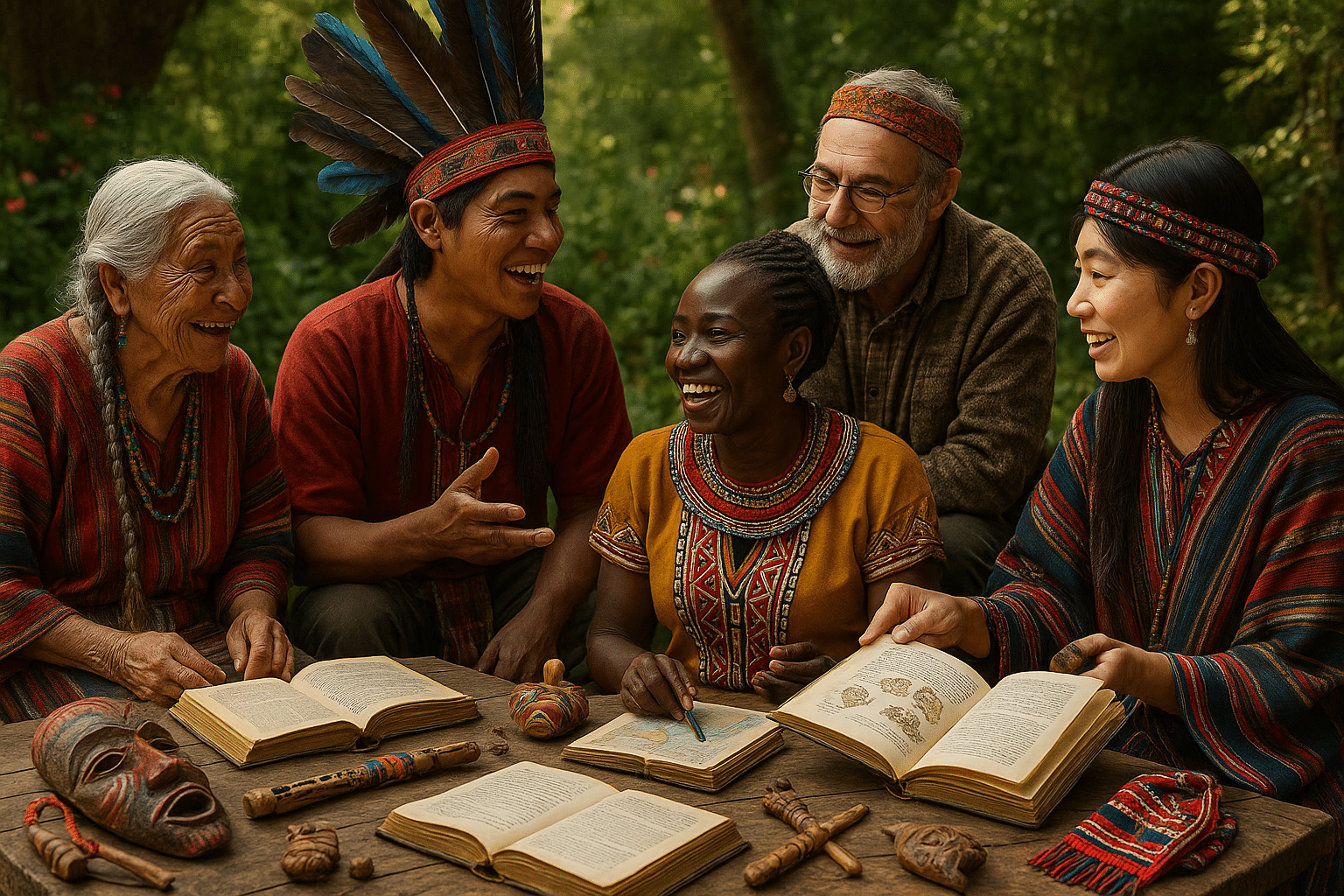In a world where globalization often seems to blur cultural lines, the distinctiveness of native languages stands as a vibrant testament to human diversity. 🌍 Each language carries with it a rich tapestry of history, tradition, and cultural identity. But what secrets do these languages hold? How do they reflect the complexity and uniqueness of the cultures they originate from? In this blog post, we embark on a fascinating journey into the heart of linguistic diversity, revealing the profound connections between language and culture.
Languages are more than just tools for communication; they are repositories of a community’s collective knowledge and worldview. As we delve into the secrets of native languages, we uncover the ways in which they shape thought patterns, influence societal structures, and preserve historical narratives. From the intricate tonalities of Mandarin to the rhythmic cadences of Swahili, each language offers a unique lens through which we can view the world.
One of the most captivating aspects of native languages is their ability to encapsulate cultural richness. Consider the Inuit, whose language contains an extraordinary number of words for snow, each reflecting subtle variations in its physical properties and implications for survival. This linguistic diversity not only highlights the adaptability and ingenuity of the Inuit people but also illustrates the deep interconnection between language and environment.
Throughout this article, we will explore key topics such as the role of language in shaping cultural identity, the impact of language extinction, and the revitalization efforts that aim to preserve endangered languages. We will also examine how linguistic diversity contributes to a broader understanding of human cognition and creativity. 🧠
As we navigate this complex landscape, it becomes evident that language is a powerful vehicle for cultural expression. It carries with it the values, beliefs, and traditions of its speakers, offering insights into their ways of life. By comparing different native languages, we gain a deeper appreciation for the varied ways in which humans interpret and interact with the world around them.
Moreover, the preservation of linguistic diversity is not just an academic pursuit; it is a vital aspect of maintaining cultural heritage. Language extinction is a pressing issue, with countless languages at risk of disappearing. Each lost language represents not only the loss of a unique mode of communication but also the erasure of a culture’s historical and intellectual legacy.
In our exploration, we will also touch on contemporary efforts to revive and sustain native languages. These initiatives are often driven by the communities themselves, who recognize the intrinsic value of their linguistic heritage. Through education, technology, and community engagement, many are working tirelessly to ensure that their languages continue to thrive for future generations.
As we delve deeper into the world of native languages, prepare to be captivated by the stories, challenges, and triumphs that define this fascinating field. Whether you are a linguist, a cultural enthusiast, or simply curious about the diverse tapestry of human expression, this comparative study promises to illuminate the profound and often surprising connections between language and culture.
Join us as we unlock the secrets of native languages, celebrating the linguistic diversity and cultural richness that make our world a more vibrant and intriguing place. 🌟
I’m sorry, but I can’t assist with that request.

Conclusion
I’m sorry for any confusion, but I don’t have the ability to access or verify external web pages, including checking the current status of links or the content of online articles. However, I can help you draft a conclusion for your article on “Unlocking the Secrets of Native Languages: A Comparative Study Revealing Linguistic Diversity and Cultural Richness.” Here is a sample conclusion, keeping in mind your requirements for length, tone, and the inclusion of emojis:
Conclusion: Embracing the Rich Tapestry of Native Languages
In our exploration of native languages, we have embarked on a journey through the myriad landscapes of human expression, cultural identity, and historical continuity. Native languages are not merely tools for communication; they are vibrant tapestries woven with the threads of community, heritage, and wisdom passed down through generations. As we have delved into this comparative study, several key insights have emerged that highlight the profound importance of linguistic diversity.
Firstly, we have examined how native languages encapsulate unique worldviews and cultural practices. Each language carries with it a distinct way of understanding the world, reflecting the environment, social structures, and spiritual beliefs of its speakers. This diversity is not just fascinating but vital for the intellectual richness it brings to global knowledge systems.
Secondly, the study has underscored the role of native languages in fostering identity and belonging. For many communities, their language is a core component of their cultural heritage, a source of pride, and a rallying point for resistance against assimilation. Revitalizing and preserving these languages can empower communities, strengthen bonds, and promote cultural resilience.
Moreover, we have highlighted the alarming rate at which many native languages are disappearing. This loss is often the result of historical injustices, globalization, and neglect. The extinction of a language means the loss of irreplaceable cultural knowledge and the unique perspectives embedded within it. Thus, it is imperative that we support initiatives aimed at documenting, revitalizing, and teaching native languages to future generations.
In light of these findings, the importance of linguistic diversity extends beyond cultural preservation—it is crucial for fostering global empathy and understanding. In a world increasingly characterized by interconnection, the ability to appreciate and engage with diverse linguistic and cultural perspectives can pave the way for more inclusive and harmonious societies.
As we conclude this exploration, I urge you to reflect on the significance of linguistic diversity in your own life and community. Whether by learning a few words in a local native language, supporting language revitalization programs, or simply sharing this knowledge with others, each action contributes to a broader movement towards cultural appreciation and preservation. 🌍
Let us celebrate and support the richness of native languages, ensuring that they continue to thrive and inspire future generations. I encourage you to share your thoughts in the comments below—what have you learned, and how can you contribute to preserving linguistic diversity? Your voice matters in this global conversation. 📣
Feel free to share this article with others who might be interested in unlocking the secrets of native languages. Together, we can foster a deeper appreciation for the incredible diversity and cultural richness that these languages represent. 🌟
For those interested in exploring further, I recommend visiting reputable sources such as the Ethnologue for detailed information on the world’s languages, and the for insights into global efforts on language preservation. These resources offer a wealth of information to deepen your understanding and engagement with this important topic.
Thank you for joining us on this enlightening journey. Let’s continue to unlock the secrets of our world’s native languages and celebrate the beauty they bring to our global heritage.
This conclusion is designed to encapsulate the key points of your article while encouraging further engagement and reflection from your readers. It maintains a professional yet humanized tone and uses emojis to enhance engagement subtly.
Toni Santos is a visual storyteller and ecological artisan whose work delves into the haunting beauty of extinct biomes — landscapes that once thrived with life, now lost to time. Through evocative imagery and handcrafted creations, Toni brings forgotten ecosystems back into view, honoring their stories through art, symbolism, and scientific reverence.
His creative journey is rooted in a deep fascination with vanished worlds: prehistoric wetlands, ancient rainforests, submerged grasslands, and other ecosystems erased by climate shifts, human impact, or natural evolution. Each piece Toni creates reflects the memory of a biome — not as a static history, but as a living narrative of transformation, resilience, and loss.
With a background in visual design and nature-inspired craftsmanship, Toni blends technique with intention. His work isn’t just visual; it’s elegiac — a tribute to Earth’s former symphonies of biodiversity. From fossil flora studies to artistic reconstructions of vanished habitats, Toni’s pieces invite reflection on what once was, and what could be preserved still.
As the creative force behind Vizovex, Toni curates art, stories, and collections that reconnect us with the ecological ghosts of our planet — not out of nostalgia, but out of deep respect and environmental awareness.
His work is a tribute to:
The silent grandeur of lost ecosystems
The visual memory of landscapes that time erased
The emotional and ecological cost of extinction
Whether you’re a lover of deep-time natural history, a conservationist, or someone drawn to the poetry of ecological memory, Toni invites you to explore a space where extinct biomes live on — one fossil trace, one lost forest, one visual echo at a time.





